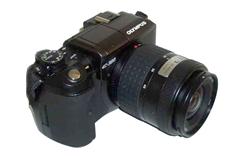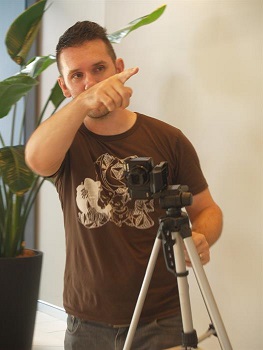 Train to be a Photo Industry Professional
Train to be a Photo Industry Professional
- Optimise your career opportunities
- Develop both your photographic skills and knowledge
- Study at your own pace; from anywhere in the world.
What Does the Course Require of You?
- This course involves fifteen modules as outlined below.
- You must complete all assignments and pass a series of fourteen exams.
- You can take all the time you need to complete these; and if you do not pass something; you are always given opportunities to try again.
- Beyond that; the course is self paced and flexible enough to fit into any lifestyle.
COURSE CONTENT
This course is made up of 15 modules, listed below. Details can be seen on the relevant websites.
Introduction to Photography
- Discuss the principles those underpins photography and examine the evolution into digital technologies.
- Explain how photographic images are able to be captured on film. This lesson will also explain how photographic images are able to be captured by digital cameras.
- Provide you with a firm understanding of how you can work at improving your capabilities with respect to taking photographs. It provides a framework, upon which you will base your work in future lessons.
- Determine appropriate application for a range of common items of photographic equipment and develop an understanding of how digital images can be transferred effectively from a digital camera
- Explain how photographic film is developed.
- Describe the process by which photographic film may be enlarged. Also explain techniques that can be used to process digital photographs within a computer to achieve improved or changed images.
- Work more effectively with light when taking photographs.
- To identify and avoid common faults in photographs
Photographic Technology
- Describe in technical terms, how an image forms when a photograph is taken.
- Explain the nature of light and how this relates to the finished photographic product.
- Describe how sensitivity of a photo sensitive surface and its development affect the photographic image.
- Explain sensitivity relates to development affect the photographic image.
- Explain the composition and manipulation of white and coloured light to create different photographic images.
- Discuss the chemical process that occurs in producing a colour film photograph.
- Explain how the photographic image may be manipulated by using optical filters or other camera attachments, other than lenses.
- Explain how the photographic image may be manipulated by using lenses.
- Compose photographs in a way that matches a predetermined aim.

- Explain a variety of ways to take better photographs of people.
- Explain a variety of ways to take better photographs of landscapes or other natural subjects.
- Differentiate between appropriate use of colour and black and white photography.
- Create varied visual affects through the use of special techniques.
- Explain a variety of ways to take better illustrative photographs.
- Explain a variety of ways to take better photographs for use in print or electronic media.
- Determine the nature and scope of business opportunities in photography.
Digital Photography
- Describe the scope and nature of digital photography.
- Select appropriate equipment for use in digital photography.
- Explain how technology enables digital images to be captured.
- Compare different digital cameras and select an appropriate camera for a particular application.
- Control the effects created in a digital photograph which you take.
- Describe techniques which can be used for digitally capturing images from film photographs, or graphics.
- Explain how digital images can be transferred effectively from a camera (or scanner) onto another device (eg. a computer, video monitor, television set, etc).
- Describe techniques that can be used to process digital photographs within a computer to achieve improved or changed images.
- Explain how digital photos can be manipulated and changed to produce altered images.
- Discuss the scope and nature of special effects that can be created with digital photographs.
- Identify how and where digital photography can effectively be used.
Travel Photography
- Identify the scope of travel photography, and the resources required to take travel photos
- Explain how you can work at improving your capabilities with respect to taking travel photographs.
- Apply camera techniques including framing, positioning, timing and borrowed landscapes to create various effects.
- Photograph natural areas to make best use of their texture, or even give them human qualities.
- Photograph streetscapes to create different moods, or capture elements of your choice.
- Photograph indoor scenes making best use of available and artificial lighting.
- Create a series of travel photographs which contain a single common feature that differentiates them from other photographs, and in doing so, provides an indication that they are likely to have been taken by the same person.
 Landscape Photography
Landscape Photography
- To know and understand the equipment and materials used in photography.
- Create different affects photographing the same landscape.
- Compose a well-balanced photo.
- Utilise form to create a three dimensional affect.
- Develop your own photographic style.
Photographing People http://www.acs.edu.au/courses/product.aspx?id=289
- Identify resources that could improve your ability to photograph people, examining the principles of photography and also exploring the issues related to digital photography.
- Discuss the preparation for a photo shoot by exploring the different equipment and materials needed for a successful shoot. Also examine lighting a subject within a studio setting and explores digital photography issues.
- Discuss techniques used for taking photos of people.
- Improve your ability to shoot better portraiture photographs.
- Explain the issues and applications concerned with wedding photography.
- Take better candid photos of people.
- Describe how to take appropriate nude photos for different situations.
- Describe how to take action photos of people.
- Describe how to take better glamour and fashion photos.
- Compile a folio of people photography.
Photographic Lighting
- Discuss the scope and nature of lighting as relevant to photography.
- Describe how different light sources will affect different images in varying ways.
- Describe how different filters can be used to create different lighting effects.
- Identify the differences between different types of light meters.
- Describe the range of equipment which can be used to help achieve more desirable light conditions for photography.
- Explain contrast and how to compensate for imperfect light conditions.
- Explain how to use tone to create the desired final image.
- Distinguish between utilisation of light in a studio and on location. To view detailed outlines of each of the modules click on the modules above, one by one.
Photoshop
- Open digital files using Photoshop.
- Resize images and save them in multiple file formats.
- Create original graphics using the Photoshop tools.
- Manipulate individual elements of a graphic composition or image.
- Improve the quality of an image (clean it up) by applying modifications.
- Apply interesting filters and effects to images or compositions.
- Prepare your files for the web, print or email.
Publishing I
- Define the scope and nature of publishing today.
- Describe some of the processes that are commonly used to perform work tasks in the publishing industry.

- Identify a viable process to follow for desktop publishing of a small publication for printing on paper.
- Identify a viable process to follow for desktop publishing of a small publication in an electronic format (eg. E book or web site).
- Evaluate different types of illustration for ease and relevance for use in different publishing situations.
- Determine photography appropriate for inclusion in a publication.
- Determine research required appropriate to the needs of a publication.
- Determine a marketing strategy appropriate to the needs of a publication.
- Identify the impact of legal and ethical issues on a publisher.
- Plan the production and marketing of a publication.
Photojournalism I
Participate in the production of a student publication
Portfolio Project
Prepare a portfolio of your photographic work
Business Studies
- Select appropriate procedures for the establishment of a small business.
- Select appropriate procedures for the management of a small business.
- Develop procedures for communicating with suppliers and customers of a small business.
- Develop procedures for addressing problems in a small business.
- Plan the management of staff in a small business.
- Develop strategies for managing production in a small business or department within a larger organisation.
- Perform different financial management tasks used in small business or department within a larger organisation.
- Evaluate marketing techniques used in business.
Research Project I
- Develop your ability to collect, collate and interpret data and prepare reports in ways relevant to the work environment.
- Monitor and evaluate one’s own work in order to develop a responsible attitude to workplace performance and quality assurance.
- Develop awareness of areas where there is a valid need for research which are relevant to area of study.
- Explain research methods, including experimental techniques, commonly used in the learner's area of study.
- Understand of the basic statistical methods used for research.
- Locate, collect and evaluate information for a specific research purpose.
- Prepare a research report in a format which conforms to normal industry procedures.
Workshops I http://www.acs.edu.au/courses/product.aspx?id=651
There are 3 lessons in this module as follows:
1. Workplace Tools, Equipment and Materials: Identifying and describing the operation of tools and equipment used in the workplace; routine maintenance of tools and equipment; identifying and comparing materials used in the workplace; using different materials to perform workplace tasks.
2. Workplace Skills: Determining key practical skills in the workplace; identifying and comparing commonly-performed workplace tasks; determining acceptable standards for workplace tasks; implementing techniques for improving workplace efficiency.
3. Workplace Safety: Identifying health and safety risks in the workplace; complying with industry OH&S standards; developing safety guidelines for handling dangerous items.
MORE OF WHAT YOU WILL DO IN THIS COURSE
In this course, amongst other things, you will learn to:
- Use a camera - film or digital – correctly to take good photographs.
- Use different photographic equipment, and use it correctly to identify and correct problems when they occur.
- Take photographs that capture and convey particular impressions about a place, its people, and their culture.
- Develop a more than basic understanding of the effects that can be achieved by manipulating composition, lighting, and equipment, and how to achieve them.
- Produce photographs and desired effects using digital technology (digital or conventional photography combined with computer software and hardware for processing the photographs).
- Use different materials and equipment to achieve specific effects in landscape photos.
- Set up a photo session – inside or outside a studio, to create different effects and convey the desired impression when photographing individuals or groups of people.
- Use and manipulate light (natural or artificial) to create different photographic affects.
- create and manipulate images and artwork compositions for the web, email and print, using Adobe Photoshop, the software used commonly in business, publishing and the graphics industry.
- Develop your understanding of publishing practices and concerns for self publishing, electronic and print publishing.
- Develop essential skills for managing a small business.
- This course provides an excellent start for anyone considering self publishing or seeking employment in publishing. It is equally relevant to electronic or print publishing.
- Gain hands-on experience in illustrating a publication with photographic images, and working cooperatively in a publication team, through a guided student publication project.
- Plan and conduct research into the current status of an aspect of the photography industry, and complete a descriptive report based on that research.
- identify, select and apply knowledge and skills to appropriate perform workplace tasks in the workplace, and adapt them to photographic practice.
- Prepare a portfolio of your photographic work in a way that reflects high standards of professionalism, and represents the range and quality of your experience and abilities.
 Moving on after Graduating
Moving on after Graduating
Photography offers a wide range of employment prospects and career paths.
The industry is a dynamic one, but one that is also in the midst of upheaval as people move away from film photography and into digital photography.
Developments in digital technology have had a huge impact on the photographic industry causing many large and well established employers to reduce job numbers. At the same time, new technologies have offered small businesses and freelance photographers an opportunity to compete more strongly than ever before with larger and more established businesses and professionals.
In summary, photography offers lots of opportunity, but it is a rapidly changing industry, and to succeed, you need to stay up to date, and have the capacity to not only adapt quickly to new technology, but also be innovative in the way you apply it and the way you move your career forward.
Photographers are employed in many different types of jobs, including:
-
Photographic Salesperson
-
Photo artist
-
Wedding Photographer
-
Portrait Photographer
-
Photo Library Manager
-
Advertising Studio Photographer
-
In House Magazine or News Photographer
-
Photography Teacher/Trainer
-
Military Photographer
-
Book Illustrator
-
Web Developer
HOW WILL THIS 1500 HOUR LEARNING BUNDLE IN PHOTOGRAPHY HELP ME?
If you want to truly get ahead in this industry then a study program is the best option – however it takes a lot of commitment and study to finish a program, but it is a lot easier (especially when you are studying online) if you are supported by your education provider.
When choosing a course the most important things to consider are:
- Choose a course of study that best suits you and your future aspirations.
- Choose a course of study that will be broad enough for you to enable you to produce designs for a vast range of clients but also for all types of settings, topography and climate.
- Choose a course of study that can be tailored to your needs and ambitions.
- Choose a course of study with a school that will encourage and support you and also give you practical along with theoretical skills.
ACS prides itself on all these things – our learning system ensures that students not only gather information but they absorb, retain and recall it (even years later). Problem Based Learning and Experiential Learning beats Competency based Training hands-down in producing quality graduates. Our courses are based on developing problem solving skills.
Will Studying Help me to be a Professional Photographer?
Many people study just to get a qualification, they rush their studies and just manage to scrape through their exams. In the workplace these people are found wanting as they just have not taken the time to gather the theoretical and practical ability to be true professionals. Advancing in a career or becoming a professional photographer isn’t just about skills and knowledge though - the industry needs graduates with:
- Sound demonstrable knowledge and skills across industry sectors but also pertinent to the job; a study program is just one part of that, many people have qualifications but it is how you are able to apply and demonstrate your knowledge that will count most to your potential employer.
- Good communication skills: verbal, written and IT skills are the very basis of a professional in any industry and photography is no exception. You need to be able to communicate effectively at all levels – with workers, your peers, your employers and importantly your clients.
- Problem solving skills: this is so lacking in many graduates from competency based courses as their range of skills is limited to what is on the ‘list’ of competencies for that course, rather than expanded through the development of problem solving skills like ACS courses. In the work place, and as a professional, you will need to problem solve all the time – you need to be able to think on your feet, come up with quick solutions and make sure that those solutions are carried through and actually work.
- Efficiency: Being efficient doesn’t necessarily mean doing things quickly – efficiency is more linked to being a good organiser, a good planner, performing tasks in the correct, logical order and applying skills with adeptness and expertise.
- Professional attitude: be well presented and a team player, most employers are looking for people who can work with others effectively and work as a team.They prefer people with a demonstrable passion for the industry and those that network in within industry; volunteering to get experience, memberships to clubs, societies, associations; reading literature all help you gain a good profile and make you stand out from others applying for the same positions.
What Can You do to Improve Your Career Prospects?
When you study do it for the right reasons; open yourself up to learning, rushing through a course won’t give you a sound basis of knowledge and skills you need to succeed. When you study know that this is the first step – these days you need to continue learning throughout your entire career to advance.
- Technology also changes rapidly so being open to learning also keeps you abreast of new industry developments: read, attend conferences, check the news in your industry, read industry papers, network and so on.
- Learn from a variety of sources: reading and learning from a variety of perspectives expands your knowledge, building a mix of skills that will make you stand out from the crowd.
- Make sure your C.V. is well written and presented and set out to current preferences –get help if you need it (tutors at this school will help our students with their C.V.'s if you ask - no cost. Resume writing services can also be used, but they charge).
- Recognise your weaknesses, and work on improving them - not just academically.